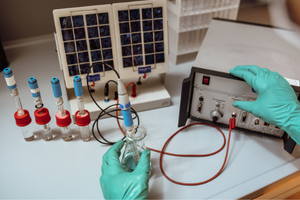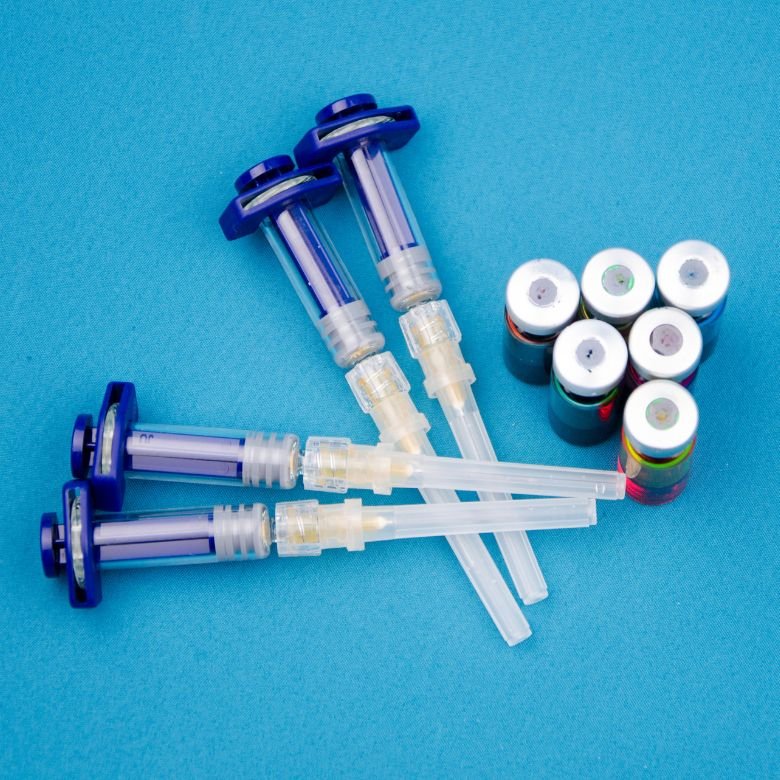The basis of electroanalytical methods is the use of solutions with electrochemical properties. Aqueous solutions of electrolytes play a particularly important role. They contain ions, i.e. moieties with a negative or positive electric charge. They also affect the electrostatic interactions that occur in electrolyte solutions.

These include the following interactions:
- ion-ion, occurring both between ions with opposite charges and with the same charges,
- ion-dipole, occurring between electrolyte ions and solvent-derived dipoles,
- dipole-dipole,
- others, such as van der Waals forces and hydrogen bonding.
The classification of electroanalytical methods
These methods include a number of measurement techniques based mainly on the exploration of electrode reactions and processes that occur between the electrodes. The basis, however, is the measurement of various electrical quantities, e.g.: voltage, current, electrical resistance, which are related to the amount of the assayed substance. They can be classified into four basic groups:
- Methods without applied external voltage, i.e. those in which the electrode reaction takes place at a zero Faraday current. An example of such a method is commonly used potentiometry – a technique based on measuring the EMF of a cell composed of non-polarized electrodes.
- Methods in which the electrode reaction takes place at a non-zero Faraday current, i.e. it takes into account the voltage applied to the electrodes from an external current source. There are many similar techniques, including: polarography, voltammetry, amperometry, electrogravimetry, coulometry.
- Methods in which no electrode reactions take place, e.g.: conductometry, oscillometry, dielectrometry.
- Methods based on the examination of changes in the electrical double layer. An example of such a technique is tensametry, based on the measurement of changes in the capacitance of the double layer, occurring as a result of adsorption or desorption of surfactants.
The most important techniques used in electrochemical analysis are classified as:
- potentiometric – based on the measurement of electrode potential, including ion-selective electrodes;
- coulometric – based on the measurement of the charge needed for complete electrolysis of the analyte;
- amperometric – based on the measurement of the current at a constant voltage;
- voltammetric – based on the measurement of the current at a controlled potential of the working electrode.
Potentiometry
This analytical technique uses the measurement of the electromotive force (EMF) of a cell made of two electrodes immersed in the test solution. The EMF value of the cell directly depends on the potentials of the electrodes. This potential is influenced by the ions present in the electrolyte solution and their activity, as well as the nature of the ongoing electrode processes.

Coulometry
As previously mentioned, coulometry is a method based on the phenomenon of electrolysis that occurs in the entire mass of the analysed solution. The quantitative relation is based on Faraday’s law, which states that the mass of the substance released at the electrode during electrolysis is proportional to the amount of the electric charge that flowed through the solution. Therefore, it is possible to calculate the released substance while measuring the flowing charge. The condition, however, is the absence of side reactions. For the measurement, coulometers are used. These devices measure the charge flowing through the electrolyte in the electrolytic vessel. Coulometric analysis is performed in two ways:
- Directly, if the analyte is oxidized or reduced at one of the electrodes. It is then possible to use two techniques – measurement at a constant electrode potential or at a constant current.
- Indirectly, if the analyte reacts with the product of the analysis. This is known as coulometric titration.
Amperometry
This technique is based on measuring the current flowing through the indicator electrode depending on the concentration of the electroactive substance at a constant potential of the indicator electrode. The intensity of the limiting diffusion current as a function of the concentration of the electroactive substance is measured. Amperometric titration is used with the application of two techniques – with one or two polarized electrodes.
Conductometry
This technique tests the electrical conductivity of a solution placed between two electrodes. It is most often used in electrolyte solutions, measuring the electrolytic conductivity. The theoretical basis of conductometry is Ohm’s law, which states that the resistance of a conductor is directly proportional to its length and inversely proportional to its cross-section area. When talking about electrolytes, we use the value of electrical conductivity, which is the reciprocal of resistance. Specific conductivity refers to the conductivity of a column of a given electrolyte with a length of 1 cm and a cross-section of 1 cm2. The ratio of these values is called the electrolytic cell constant. The conductivity depends on the type of electrolyte, its concentration and temperature. The measurement using the classical conductometry technique is based on the measurement of the conductivity of the solution column located between two platinum electrodes to which a variable voltage (1-10 kHz) is applied. There are also other variants of the technique, such as the electrodeless technique, the direct technique and conductivity titration.

Voltammetry
The result of measurements with this technique are graphs showing the dependence of the current on the potential of the working electrode, which have the nature of a spectrum. Under given conditions and using the same solvent, many substances have oxidation or reduction waves at distinctive potentials. Thus, the qualitative determination of the analyte is possible. In this technique, the dependence of the current intensity on the voltage applied to the electrodes is measured. There are several ways to use this technique: voltammetry with linearly varying potential, cyclic voltammetry and inverted voltammetry. Among them, the most popular one is cyclic voltammetry, in which electrolytic cells with three electrodes are used. Each of them fulfils specific functions. The first is the working electrode, the second is the auxiliary electrode and the third is the reference electrode. The current is passed between the working and auxiliary electrodes. The potential of the working electrode is measured and then set relative to the reference electrode. This is how one actually sets the voltage between the working and reference electrodes. Then, the current flows and, depending on the processes occurring on both electrodes, their potentials are set. The difference between them is equal to the voltage applied.
Polarography
This technique is very similar to voltammetry, but differs in the electrode used. For voltammetric techniques, the working electrode is always stationary. In contrast, in the case of polarography, the working electrode is a liquid electrode (Hg) with a surface that is renewed continuously or periodically. The term covers many techniques, including: classic polarography – DC, AC sinusoidal, AC rectangular and pulsed differential.
